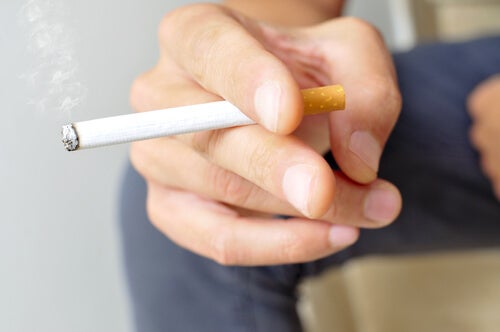Smoking Increases the Risk of Complications with COVID-19

Acute respiratory tract infections affect the general population. However, they’re more prevalent in elderly people and those with weakened immune systems. These people can suffer severe complications (Knipe, 2013). It’s a proven fact that coronaviruses attack the lungs and can cause pneumonia. Thus, smoking increases the risk of complications when a person is infected with COVID-19.
Acute respiratory infections are very common in the general population, and most of them are due to viral infections. However, there aren’t many studies on the role of viruses in acute respiratory infections in adults. And, in addition to this, even fewer analyze the role of coronaviruses (Talbot and False, 2010).
The researchers point out that there’s no specific reason why men are more susceptible to COVID-19. Some researchers, however, point out that this may be due to what the WHO has described as a “biologically inherent advantage” for women.
Smoking kills approximately six million people every year. Five million are consumers and more than 600,000 are passive smokers (those who are exposed to other people’s smoke). Therefore, this is a higher mortality rate than that caused by both drugs and alcohol combined.

Does smoking increase the complications with a COVID-19 infection?
A study conducted in 2014 in Palma de Mallorca specified the clinical and epidemiological characteristics of adult patients with respiratory infections caused by coronaviruses OC43, NL63, and 229E.
Acute respiratory infections caused by coronaviruses mainly affect middle-aged male smokers. They’re often affected by previous illnesses (Reina, López-Causapé, Rojo-Molinero and Rubio, 2014).
Smoking is one of the main predisposing factors of many respiratory diseases and, among others, of viral infections. Twenty-three of the patients in the above-mentioned study (47.9%) were also active smokers. The authors state that they have no conflict of interest.
Gisli Jenkins, a professor at the University of Nottingham, has an explanation for this. She explains that smoking increases the risk of chronic obstructive pulmonary disease (COPD). In addition, people with COPD are at a higher risk of suffering coronavirus-related respiratory disease.
Smoking is responsible for 33% of cancers in men and 10% in women. In addition, up to 90% of lung cancers are due to smoking.

Complications when there’s a coronavirus infection
The most frequent complications of coronavirus infection are non-specific influenza (43.7%), pneumonia (29.2%), and acute chronic obstructive pulmonary disease (COPD) (8.3%). Fifty-two percent of patients required intensive care hospital admission on two occasions (Reina et al., 2013).
Although we can detect them throughout the year, the incidence of coronavirus infections follows a seasonal pattern. This is predominantly in the winter months (Talbot and False, 2010).
In some studies, experts observed that OC43 tends to appear biannually, with a stronger presence in the first quarter of the year. In the study by Reina et al (2013), the incidence of respiratory infections due to coronavirus was detected throughout the year. However, the majority of the cases (58.3%) occurred between the months of January and March.
Hope on the horizon
Finally, there may be some hope on the horizon… Researchers from the Spanish National Research Council (CSIC) have demonstrated in vitro that the drug Aplidin (plitidepsin) is able to stop the multiplication of the coronavirus HcoV-229E. This strain belongs to the family of the new coronavirus that caused the current pandemic, confining nearly half the world’s total population to their homes.
Researchers are now going to study whether this drug is also effective against the SARS coronavirus. This is very similar to the SARS-CoV-2 that causes COVID-19 disease.
Specialists, such as CSIC virologist Isabel Sola, who has more than twenty years’ experience studying coronaviruses, say it could be a matter of two or three months to discover whether this drug is effective against the new coronavirus.
Smokers have a mortality rate of over 70% related to cardiovascular disease, chronic bronchitis, lung cancer, and pulmonary emphysema.
All cited sources were thoroughly reviewed by our team to ensure their quality, reliability, currency, and validity. The bibliography of this article was considered reliable and of academic or scientific accuracy.
D.M. Knipe, P.M. Howley (Eds.), Fields virology (6th ed.), Wolters Kluwer, Philadelphia (2013), pp. 825-858
Reina, J., López-Causapé, C., Rojo-Molinero, E., & Rubio, R. (2014). Características de las infecciones respiratorias agudas causadas por los coronavirus OC43, NL63 y 229E. Revista Clínica Española, 214(9), 499-504.
This text is provided for informational purposes only and does not replace consultation with a professional. If in doubt, consult your specialist.








